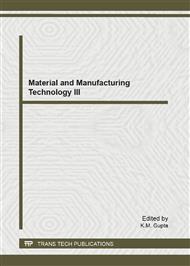p.110
p.115
p.119
p.123
p.128
p.133
p.138
p.143
p.147
Fabrication and Characterization of Degradable Biomaterial Block Polymer PLGA Nanoparticles Modified by MePEG
Abstract:
The block polymer methoxy(polyethylene glycol)-poly(dl-lactide-co-glycolic acid) (MePEG-PLGA) nanoparticles were fabricated by modified spontaneous emulsification/solvent evaporation method, and further characterized their shape, size, zeta potential, glass transition temperature and other items by scanning electron microscopy, laser granulometry, differential scanning calorimetry (DSC), fourier transform infrared spectrometer and differential scanning calorimeter. Meanwhile, the effects of cytotoxicity of MePEG-PLGA nanoparticles on human ARPE-19 cells. The results indicated that the mean size of MePEG-PLGA nanoparticles was about 368.1nm, zeta potential was -32.6mV in distilled water and the start of glass transition temperature 26.75 centigrade degree. The fabricated MePEG-PLGA nanoparticles had narrow size distribution and were block polymer of PEG and PLGA detected by fourier transform infrared spectrometer and have good physical- and chemical-characterization. Additionally, no cytotoxicity was found for the MePEG-PLGA nanoparticles on human ARPE-19 cells. These results indicated that MePEG-PLGA nanoparticles have good biocompatibility and could be applied in drug delivery.
Info:
Periodical:
Pages:
128-132
Citation:
Online since:
July 2012
Authors:
Price:
Сopyright:
© 2012 Trans Tech Publications Ltd. All Rights Reserved
Share:
Citation:


